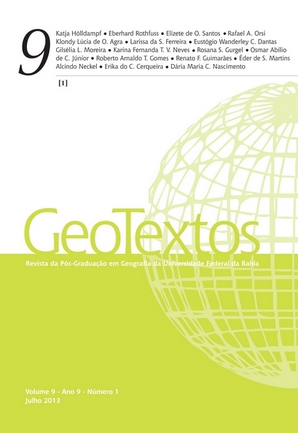THE ROLE OF CARTOGRAPHY IN THE TEACHING OF GEOGRAPHY: PERSPECTIVES FROM AN EXTENSION PROJECT
DOI:
https://doi.org/10.9771/1984-5537geo.v9i1.8354Keywords:
Teaching of cartography, Teaching of geography, Cartographic literacyAbstract
This paper aims to discuss the role of cartography in the teaching of geography. In order to do so it brings theoretical and practical results of the research project and extension called “Popularization of cartography and its new technologies in public school,” held in the State School Dona Mora Guimarães (Cazajeiras X, Salvador- BA). It is considered that the teaching of cartography, despite the epistemological advances, has experienced several difficulties in its implementation. To analyze the barriers, potentialities, and examples of pedagogical practice, workshops were held focusing on the concepts of cartographic literacy - vision vertical/horizontal, laterality, decoding of symbols, proportionality, two-dimensional X three-dimensional representation and use of new technologies. It is advocated that cartographic literacy can be used as an innovative methodology for the teaching of geography in schools. In parallel, the difficulties found in a university and school context are discussed. Finally, successful experiences are shared with more than 400 students involved directly, who used technical and methodological resources, from where they live and constructivist approach, namely: mapping of the human body, of the classroom and building of models. It is concluded that the theme has many challenges, but lacks mainly the expansion of this debate to overcome the dissociative barriers, putting the cartography as means of communication of the geographical science.Downloads
Downloads
Published
How to Cite
Issue
Section
License
Autores que publicam nesta revista concordam com os seguintes termos:
Autores mantém os direitos autorais e concedem à revista o direito de primeira publicação, com o artigo simultaneamente licenciado sob a Licença Creative Commons Creative Commons CC BY que permite o compartilhamento do trabalho com reconhecimento da autoria e publicação inicial nesta revista. Esta licença permite que outros distribuam, remixem, adaptem e criem a partir do seu trabalho, mesmo para fins comerciais, desde que lhe atribuam o devido crédito pela criação original. É a licença mais flexível de todas as licenças disponíveis. É recomendada para maximizar a disseminação e uso dos materiais licenciados. Ver o resumo da licença em: https://creativecommons.org/licenses/by/4.0/ Ver o texto legal da licença em: https://creativecommons.org/licenses/by/4.0/ Consulte o site do Creative Commons: https://creativecommons.org/licenses/?lang=pt
Autores têm autorização para assumir contratos adicionais separadamente, para distribuição não-exclusiva da versão do trabalho publicada nesta revista (ex.: publicar em repositório institucional ou como capítulo de livro), com reconhecimento de autoria e publicação inicial nesta revista.
Autores têm permissão e são estimulados a publicar e distribuir seu trabalho online (ex.: em repositórios institucionais ou na sua página pessoal) a qualquer ponto antes ou durante o processo editorial, já que isso pode gerar alterações produtivas, bem como aumentar o impacto e a citação do trabalho publicado (Veja O Efeito do Acesso Livre).






